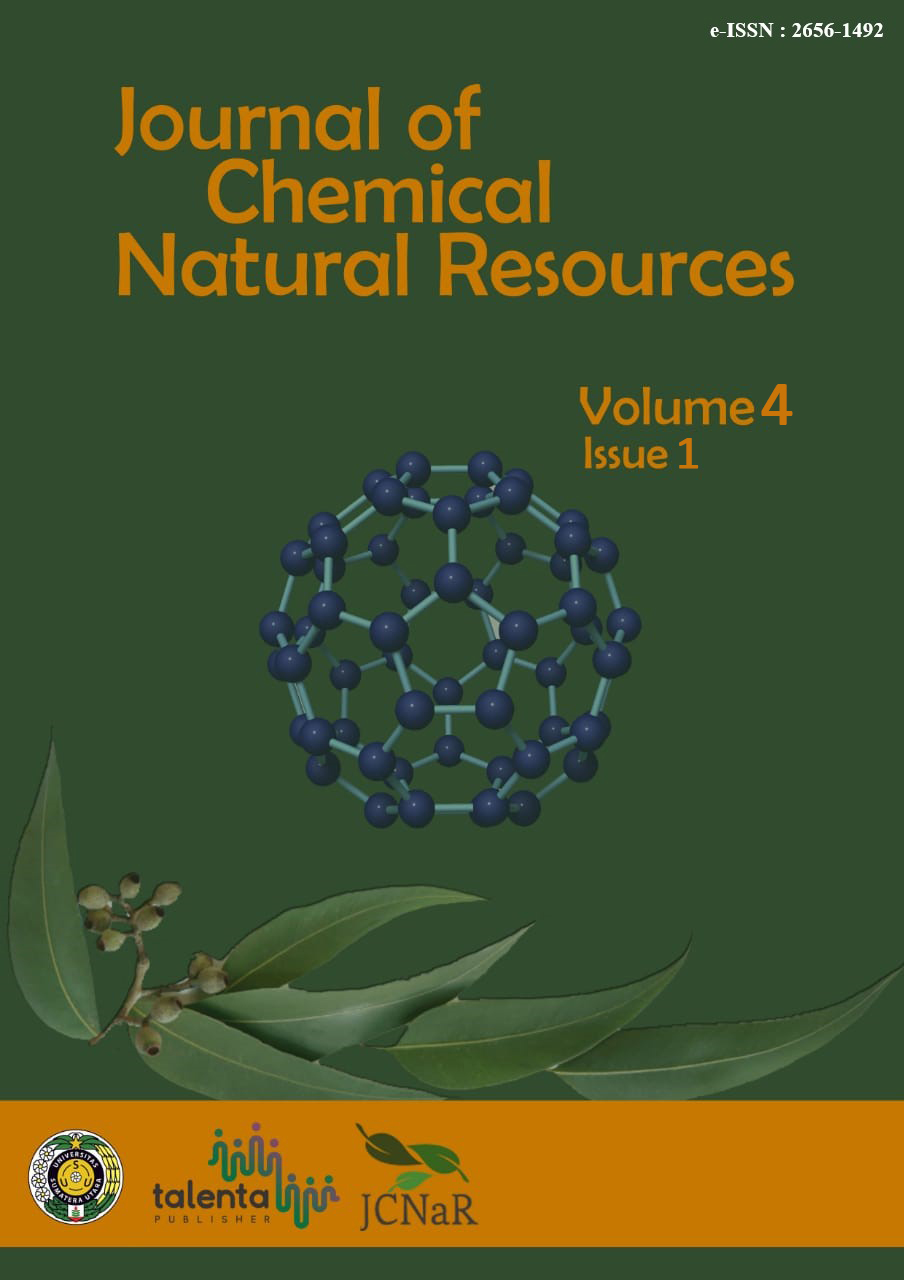Calcium Silicate as a Media For Enhancement of Vitamin E Concentration from Candlenut Oil (Aleurites moluccana)
DOI:
https://doi.org/10.32734/jcnar.v4i1.9357Keywords:
Adsorbent, Antioxidant, Calcium Silicate, Candlenut Oil, Vitamin EAbstract
Vitamin E consists of two parts, namely tocopherol and tocotrienol which are found as minor components in candlenut oil. The process of increasing vitamin E concentrate in candlenut oil aims to obtain higher vitamin E levels from candlenut oil through a major and minor component separation with adsorption and desorption methods with three types of calcium silicate hydrate adsorbent namely calcium silicate with 90% absolute ethanol (Ca-S 90), calcium silicate with 75% absolute ethanol (Ca-S 75) and calcium silicate synthesized from CaO (Ca-S). The three adsorbents were synthesized by hydrothermal method at 170ºC for 24 hours accompanied by stirring and characterized by XRD, SEM-EDX, and BET. Furthermore, the adsorbent was applied to enrich vitamin E concentrate in candlenut oil through the adsorption process using a glass column with a mass ratio between candlenut oil and adsorbent that was 1:1, then the vitamin E desorption process was carried out by adding n-hexane solvent. Vitamin E levels obtained after the adsorption and desorption process were for Ca-S 75 adsorbent was 764.41 ppm (1. 82 times enriched), for Ca-S 90 adsorbent was 1011.29 ppm (2. 40 times enriched) and for Ca-S adsorbent was 1029, 38 ppm (2.4 5 times enriched) from the initial vitamin E level in candle nut oil was 420.66 ppm. Ca-S adsorbent showed the best vitamin E enrichment.
Downloads
References
Aguilar F, Autrup H, Barlow S, Castle L, Crebelli R, Dekant W, Engel KH, Gontard N, Gott D, Grilli S, Gurtler R, Larsen JC, Leclercq C, Leblanc JC, Malacta X, Mannes W, Milana MR, Pratt I, Rietjens I, Tobback P, Toldra F, 2008. Opinion on Mixed Tocopherols, Tocotrienol tocopherol, and Tocotrienol as Sources for Vitamin E Added as A Nutritional Substance in Food Supplements. The EFSA Journal, 640:1-34.
Beytut E, Yilmazb S, Aksakalc M, Polatd S, 2018. The possible protective effects of vitamin E and selenium administration in oxidative stress caused by high doses of glucocorticoid administration in the brain of rats. Journal of Trace Elements in Medicine and Biology, 45: 131–135.
Chu BS, Baharin BS, Che Man YB, Quek SY, 2004. Comparison of Selected Adsorbents for Adsorption and Desorption of Vitamin E from Palm Fatty Acid Distillate. Journal of Food Lipids, 12:23-33.
Condon JB, 2006. Surface Area and Porosity Determinations by Physisorption Measurements and Theory. USA. Elsevier.
Duhem N, Fabienne D, Veronique P, 2014. Vitamin E-based Nanomedicines for Anti-cancer Drug Delivery. Journal of Controlled Release, 182: 33-44.
Gadde HK, 2017. Effect of Hydration and Confinement on Micro-Structure of Calcium Silicate-Hydrate Gels. [Thesis]. Boulder: University of Colorado, Civil, Environmental and Architectural Engineering Department.Garbev K, Black L, Beuchle G,
Stemmermann P, 2002. Inorganic Polymers in Cement Based Materials. Nachrichten aus dem Institut für Technische Chemie, 2: 19–30.
Guan W, Zhao X, 2016. Fluoride Recovery Using Porous Calcium Silicate Hydrates Via Spontaneous Ca 2+ and OH - Release. Separation and Purification Technology, 165: 71–77
Huang R, Wu M, Zhang T, Li D, Tang P, Feng Y, 2017. Template-free Synthesis of Large –Pore-Size Porous Magnesium Silicate Hierarchical Nanostructures for High-Efficiency Removal of Heavy Metal Ions. ACS Sustainable Chemistry and Engineering. ACS Sustainable Chem. eng. xxxx, xxx, xxx – xxx : AG.
Krisnawati H, Kallio M, Kanninen M, 2011. Aleurites moluccana (L.) Willd. Ecology, silviculture, and productivity. Bogor. CIFOR.
Lambert WE, De Leenheer AP, 2000. Vitamin/Fat-Soluble: Thin-Layer (Planar) Chromatography. Belgium. Academic Press.
Li X, 2015. Anti-aging cosmetics and its efficacy assessment methods. IOP Conf. Ser.: Mater. science. Eng, 87:1-5.
Magdy BW, Mohamed FES, Amin AS, Rana SS, 2016. Ameliorative effect of antioxidants (vitamins C and E) against abamectin toxicity in liver, kidney, and testis of male albino rats. The Journal of Basic & Applied Zoology, 77: 69–82.
Malherbe RMAR, 2006. Adsorption and Diffusion in Nanoporous Materials. USA. CRC Press.
Pizzino G, Irrera N, Cucinotta M, Pallio G, Mannino F, Arcoraci V, Squadrito F, Altavilla D, Bitto A, 2017. Oxidative Stress: Harms and Benefits for Human Health. Hindawi Oxidative Medicine and Cellular Longevity : 1-13.
Reveny J, Tanuwijaya J, Stanley M, 2017. Formulation and Evaluating Anti-Aging Effect of Vitamin E in Biocellulose Sheet Mask. International Journal of ChemTech Research, 10(1): 322-330.
Riaz MN, Asif M, Ali R, 2009. Stability of Vitamins during Extrusion. Critical Reviews in Food Science and Nutrition, 49:361–368.
Sebayang F, Bangun N, Bulan R, Kaban J, Putri NK, 2016. Enrichment of Tocopherol and Tocotrienol Using Polar Adsorbents From Candlenut Oil. Int'l Journal of Advances In Chemical Engg., & Biological Sciences (IJACEBS), 3(1):23-26.
Silitonga AS, Masjuki HH, Mahlia TMI, Ong HC, Chong WT, Boosroh MH, 2013. Renewable and Sustainable Energy Reviews, 22: 346–360.
T Do TD, Cozzolino D, Muhlhausler B, Box A, Able AJ, 2015. Antioxidant capacity and vitamin E in barley: Effect of genotype and storage. Food Chemistry, 187: 65–74.
Uwa LM, 2017. The Anti-aging Efficacy of Antioxidants. Curr Trends Biomedical Eng & Biosci, 7(4): 1-3.
Yakub I, Sutan NM, Kiong CS, 2013. Characterization of Calcium Silicate Hydrate and Calcium Hydroxide in Nanosilica Binder Composites. Nano Studies, 7:57-62.
Downloads
Published
Issue
Section
License
Copyright (c) 2022 Journal of Chemical Natural Resources

This work is licensed under a Creative Commons Attribution-ShareAlike 4.0 International License.















